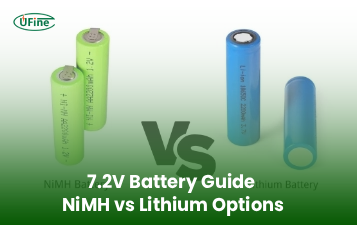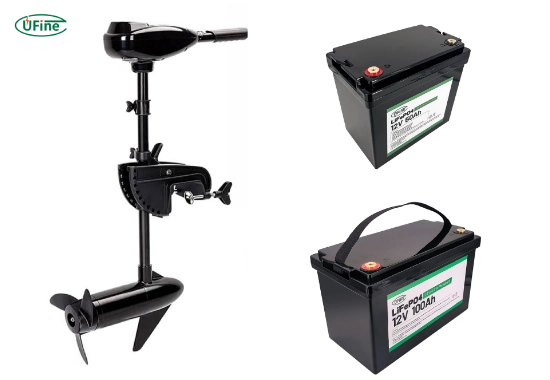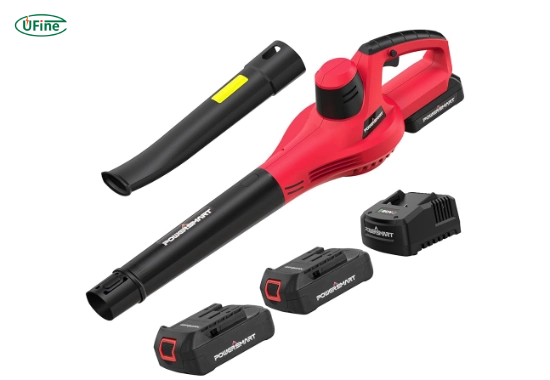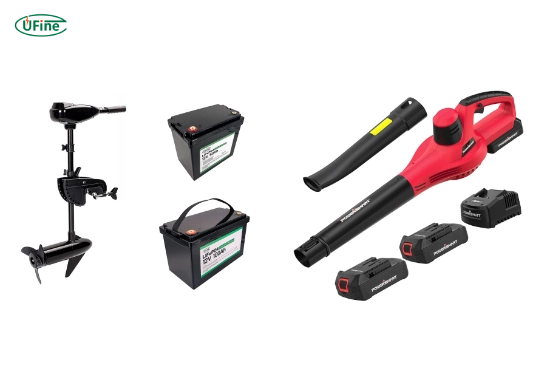
- Part 1. What are batteries for trolling motors lightweight?
- Part 2. Why does battery weight matter for trolling motors?
- Part 3. What kind of batteries do leaf blowers use?
- Part 4. Can you use a leaf blower battery for a trolling motor?
- Part 5. Key benefits of lightweight trolling motor batteries
- Part 6. Comparing power output: trolling motor vs. leaf blower batteries
- Part 7. Why lithium-ion is the top choice for trolling motors?
- Part 8. How to choose the best trolling motor battery for your needs
- Part 9. Top brands for trolling motor batteries lightweight
- Part 10. Real-world use cases and performance analysis
- Part 11. FAQs about lightweight battery for trolling motor
What are the best batteries for trolling motors lightweight, and how do they compare to the batteries found in leaf blowers? If you’re a boat enthusiast or an angler looking for maximum performance and portability, this question has likely crossed your mind. Choosing the right battery can make the difference between a smooth, enjoyable ride and a frustrating experience with limited run time or heavy gear.
In this in-depth guide, we will explore everything you need to know about lightweight trolling motor batteries. We will compare them with leaf blower batteries, break down their performance, and help you understand the best options available today. Whether you’re new to boating or an experienced user upgrading your setup, this article is designed to provide you with clear, practical answers.
Part 1. What are batteries for trolling motors lightweight?
Lightweight batteries for trolling motors are compact, high-performance energy sources designed to power electric motors used in boats, kayaks, and other watercraft. These batteries are engineered to be light in weight, high in energy density, and capable of operating for extended periods without needing a recharge.
Most lightweight options today are made from lithium iron phosphate (LiFePO4), a type of lithium-ion battery known for its safety, stability, and efficiency. Compared to traditional lead-acid batteries, they are significantly lighter, more durable, and far more efficient in terms of charge retention and discharge rates.
These batteries are ideal for applications where space and weight are limited, such as in fishing kayaks, small boats, and portable watercraft. The ability to deliver consistent power over time makes them a top choice for trolling motors.
Part 2. Why does battery weight matter for trolling motors?
Battery weight plays a critical role in the performance and usability of a trolling motor. The lighter the battery, the less overall weight your boat has to carry, which results in:
- Better fuel efficiency or battery run time
- Improved speed and maneuverability
- Easier handling both on and off the water
- Lower physical strain when transporting the battery
In small watercraft like fishing kayaks or inflatable boats, even a few extra pounds can have a noticeable effect. Traditional lead-acid batteries often weigh over 60 pounds, while modern lithium-ion options may weigh as little as 10 to 20 pounds. This difference translates to better balance on the water, faster acceleration, and easier portability.
Part 3. What kind of batteries do leaf blowers use?
Leaf blowers typically use compact lithium-ion batteries designed for short-duration, high-power discharge. These batteries are built to deliver a burst of energy over a period ranging from 10 to 45 minutes, depending on the voltage and amp-hour rating.
Common specifications include:
- Voltage: 20V, 40V, 60V, or 80V
- Capacity: 2Ah to 8Ah
- Weight: Usually less than 5 pounds
- Charging time: 30 minutes to 2 hours
The batteries are optimized for tools that require strong but short bursts of power. They are lightweight and very portable but are not intended for continuous use over multiple hours, which is essential for trolling motors.
Part 4. Can you use a leaf blower battery for a trolling motor?
While it might sound convenient to reuse a leaf blower battery for a trolling motor, in practice, this is not a viable solution.
Here are the main reasons:
- Leaf blower batteries are not designed for continuous discharge
- They have low amp-hour ratings and short runtimes
- They are not waterproof or built for marine conditions
- Voltage compatibility issues are common
- They lack thermal and discharge protections needed for trolling motors
Using a leaf blower battery on a trolling motor could result in underpowered operation, overheating, or even permanent damage to the motor or battery. It is always safer and more efficient to use a battery that is specifically designed for marine use.
Part 5. Key benefits of lightweight trolling motor batteries
Batteries designed specifically for trolling motors offer several advantages that leaf blower batteries cannot match. These include:
- Extended run time: Many lithium trolling motor batteries can power a motor for 4 to 10 hours depending on load
- High energy density: More power in a smaller and lighter package
- Long lifespan: Up to 3000 charge cycles, which may last 8 to 10 years
- Stable voltage output: Maintains full performance even when the battery charge drops
- Fast charging: Many models can fully recharge in just 2 to 4 hours
- Durability: Built with waterproof and vibration-resistant casings
These features make lightweight lithium batteries the ideal power source for boaters who need reliability and convenience without sacrificing performance.
Part 6. Comparing power output: trolling motor vs. leaf blower batteries
Let’s compare the technical details of the batteries used in trolling motors and leaf blowers to gain a clearer understanding of their differences.
| Feature | Trolling Motor Battery (Lightweight) | Leaf Blower Battery |
|---|---|---|
| Voltage | 12V, 24V, or 36V | 20V to 80V |
| Amp-Hour Capacity | 20Ah to 100Ah | 2Ah to 8Ah |
| Runtime | 4 to 10 hours | 10 to 45 minutes |
| Discharge Type | Continuous | Short bursts |
| Waterproofing | Usually IP65 or higher | Not waterproof |
| Weight | 10 to 30 lbs | 2 to 5 lbs |
| Usage Environment | Marine, freshwater, outdoor | Dry land, gardens, patios |
This table shows that while leaf blower batteries may be lightweight and compact, they are not suitable for the sustained power demands of a trolling motor.
Part 7. Why lithium-ion is the top choice for trolling motors?
Lithium-ion batteries, especially LiFePO4 variants, are becoming the industry standard for powering trolling motors. Here’s why:
- Lightweight design: Up to 70 percent lighter than lead-acid alternatives
- Higher usable capacity: You can use nearly 100 percent of the battery’s capacity without risk of damage
- Stable voltage curve: Delivers consistent performance from full charge to empty
- Fast charging times: Most models recharge in under four hours
- Low self-discharge: Can hold a charge for months
- Built-in battery management system (BMS): Protects against overcharging, overheating, and deep discharge
- Eco-friendly: No harmful fumes or acid leaks
Their superior performance and long lifespan make them a smart investment for anyone who values efficiency and convenience on the water.
Part 8. How to choose the best trolling motor battery for your needs
When selecting a battery for your trolling motor, consider the following factors:
- Motor voltage requirements: Match the battery voltage to your motor’s specifications
- Amp-hour rating: Determines how long the battery can run before needing a recharge
- Weight and size: Consider portability and storage space on your boat
- Charge time: Look for batteries with fast recharging capabilities
- Waterproof rating: IP65 or higher is recommended for marine use
- Warranty and support: A good lithium battery should come with a 5 to 10-year warranty
- Compatibility with solar charging: Useful for extended trips
Spending a little more on a quality battery can save you time, frustration, and money in the long run.
Part 9. Top brands for trolling motor batteries lightweight
There are several companies offering high-quality lightweight lithium batteries for marine use. Among the most trusted brands are:
- Dakota Lithium: Known for high-performance LiFePO4 batteries with long warranties
- Battle Born Batteries: Offers reliable and rugged lithium options for marine and RV use
- Relion: A popular choice among pro anglers and boaters for its consistent output
- Ampere Time: Offers affordable options with solid safety features
- Bioenno Power: Focuses on portable and solar-compatible marine batteries
Ufine Battery deserves a special mention. Ufine provides highly customizable lithium battery solutions, tailored specifically to meet your boat’s power requirements. Whether you need unique voltage, amp-hour ratings, or form factors, Ufine works closely with customers to deliver made-to-order battery systems that combine safety, performance, and longevity. This level of flexibility makes Ufine an excellent choice for those needing a personalized battery solution.
Part 10. Real-world use cases and performance analysis
Let’s look at how lightweight trolling motor batteries perform in real-world conditions.
Fishing kayaks
Many anglers prefer lightweight lithium batteries in their kayaks due to the limited space. A 12V 30Ah battery can easily power a trolling motor for 5 to 6 hours, while only weighing 10 pounds. This allows for a full day of fishing without worrying about battery swaps or recharging.
Inflatable boats
Inflatable boats benefit significantly from reduced weight. A compact LiFePO4 battery reduces onboard weight and increases buoyancy, making the boat easier to control in current or wind.
Pontoon boats
For larger boats with multiple motors or onboard accessories, 24V or 36V lithium batteries provide more power and longer run time. These batteries can be linked in series or parallel, depending on the setup.
Part 11. FAQs about lightweight battery for trolling motor
Can I use a leaf blower battery for a trolling motor?
No, leaf blower batteries are not designed for long-duration, continuous power usage or marine environments. They may not meet voltage or amp-hour requirements.
What is the best type of battery for a trolling motor?
Lithium iron phosphate (LiFePO4) batteries are the best due to their lightweight design, long lifespan, and consistent power output.
How long does a lightweight trolling motor battery last?
Depending on its amp-hour capacity and the motor’s power draw, a lithium battery can last between 4 to 10 hours per charge and up to 10 years in total lifespan.
Are lightweight trolling motor batteries safe to use?
Yes, as long as they include a built-in Battery Management System and are designed for marine use. Look for waterproof ratings and thermal protection features.
What makes Ufine Battery a good choice?
Ufine Battery offers custom-built lithium battery solutions, allowing users to specify voltage, capacity, size, and safety features. This ensures optimal performance tailored to your specific marine setup.
Related Tags:
More Articles

NiMH vs Lithium 7.2V Battery and Charger: Which Is Better?
Compare 7.2V NiMH vs Lithium batteries and chargers in 2025. Learn runtime, weight, charging, lifespan, and cost to choose the best for your device.
How to Choose the Right 7.2V Battery and Charger for Your Device?
Learn how to choose the right 7.2V battery and charger for optimal performance, safety, and longevity across RC, tools, medical, and industrial devices.
Big Square Battery Safety Standards You Must Know
Learn key safety standards for big square batteries to avoid fire risks, shipping delays, and compliance issues in EV, industrial, and energy storage projects.
Big Square Battery Applications in Solar & Industrial Equipment
Big square batteries deliver high capacity, stable output, and long life for solar, industrial, and backup power. Explore key uses and advantages.
Big Square Battery vs Cylindrical Battery: Complete 2025 Guide for EVs, ESS & Industrial Devices
Choosing the right battery is key for designers and engineers. Compare big square vs cylindrical batteries to find the best fit for your application.





